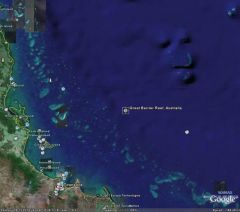-
Posts
4,115 -
Joined
-
Last visited
Content Type
Profiles
Forums
Gallery
Events
Store
Everything posted by Caribbean Jake
-

What to do if a SPS is dieing/bleaching/RTN?
Caribbean Jake replied to bk_market's topic in General Discussion
1) cut the dead pieces off and take them out of the tank to prevent dicease from spreading. 2) move the rest of the live coral or frags (what is left of it) to the bottom of your tank, and continue to monitor (repeat step 1 if necessary) 3) provide slow flow through the area but not directed towards the coral this method will increase your chances of saving the piece, but be aware that will take anywhere from 2 to 8 month for the piece to recover. good luck. Jacob -

Record Bull Shark: 512 Pounds
Caribbean Jake replied to Caribbean Jake's topic in General Discussion
Recetly someon cought a Mako off Shore near Mexico/Texas that is 10.5 feet long. Is small for Mako standards copmpared to those 17+ feet off the Australia coast, but still big boy for this area. -

Record Bull Shark: 512 Pounds
Caribbean Jake replied to Caribbean Jake's topic in General Discussion
will you imagine yourself swiming with this shark before he was cought? -
Angler Pulls In Texas State Record Bull Shark: 512 Pounds, 9 Feet Long http://www.underwatertimes.com/news.php?ar..._id=10164052839 Underwatertimes.com News Service Port Aransas, Texas (May 25, 2007 13:24 EST) A new state record bull shark was caught in Aransas Bay last week by Randall Rickerson of Corpus Christi. The previous state record was a 508-pound shark caught in the Gulf. This one, caught on Friday, May 18, weighed in at 513 pounds and was nine feet long. Rickerson reportedly had a two hour and 10 minute fight to bring it in and then it took 2-1/2 hours to tow in the boat and shark. The big catch was stored in the Fisherman's Wharf walk-in cooler until a scale big enough could be brought over to weigh it.
-
Underwatertimes.com News Service http://www.underwatertimes.com/news.php?ar..._id=01035641728 Montreal, Quebec (May 28, 2007 16:13 EST) A team of researchers from McGill University and the Smithsonian Tropical Research Institute (STRI) has provided the first example of how color patterns on a coral reef fish species can drive its evolution into many distinct species.
-
http://www.msnbc.msn.com/id/18889470/ By Juliet Eilperin Updated: 5:24 a.m. ET May 27, 2007 LAS BARRANCAS, Mexico - Year after year, beach season brings accounts of harrowing shark attacks as people around the world plunge into the surf to escape summer's heat. But the reality is that these fearsome predators kill an average of four people worldwide every year, while humans kill anywhere from 26 million to 73 million sharks annually, according to recent calculations by an international team of scientists. With the latter toll mounting rapidly in recent years, there has been a growing realization that something must be done to prevent sharks from disappearing from the planet. Two weeks ago, Mexico, which has a large shark fishery, enacted a new law that protects three species, bans the practice of shark "finning" -- slicing off the fins of a newly caught shark and tossing the animal back in the ocean to die -- and requires authorities to monitor the activities of large shark-fishing boats. Early next month, officials from around the globe will meet in The Hague, Netherlands, to decide whether to put tight new controls on the trade in two heavily fished species, spiny dogfish and porbeagle, under the Convention on International Trade in Endangered Species (CITES). "For most of human history, sharks have been seen as a threat to us," David Balton, the U.S. deputy assistant secretary of state for oceans and fisheries, said in a recent interview. "Only recently are we beginning to see we're a threat to them." Worldwide deaths by shark attacks have dipped Unprovoked shark attacks off U.S. shores have risen over the past century, as Americans have flocked to the coasts and researchers have collected more careful statistics. Yet the number of deaths worldwide has dipped slightly in recent years, according to the International Shark Attack File, compiled by the American Elasmobranch Society and the Florida Museum of Natural History. Occasionally, the number of deadly attacks spikes, as it did in 2000 when sharks killed 11 people. The declines in shark populations have been steep, as documented recently by scientists using technologies including satellite tracking and DNA analysis. In March, a team of Canadian and U.S. scientists calculated that between 1970 and 2005, the number of scalloped hammerhead and tiger sharks may have declined by more than 97 percent along the East Coast, and that the population of bull, dusky and smooth hammerhead sharks dropped by more than 99 percent. Globally, 16 percent of 328 surveyed shark species are described by the World Conservation Union as threatened with extinction. From Mexico to Indonesia, much of the hunt for sharks is driven by the growing demand for shark-fin soup, a prized delicacy that conveys a sense of status in Asian countries whose citizens are enjoying newfound wealth. On a recent spring afternoon in the tiny camp of El Chicharon outside Las Barrancas, two brothers, Francisco and Armando Bareno, returned to shore with a catch of two dozen mako and blue sharks. At the edge of the water, they began slicing off the fins so they could pack them separately onto a truck bound for Mexico City, more than 1,000 miles away. The fins are so much more valuable than the meat that without the fin market, many fishermen might not bother to hunt sharks at all: The Bareno brothers get 1,000 pesos, or $100, per kilogram (2.2 pounds) for the dried fins they deliver. The shark meat fetches just 15 pesos, or less than $1.50, a kilo.
-
http://www.khnl.com/Global/story.asp?S=6572424 By Diane Ako HONOLULU (KHNL) - At a lengthy meeting Friday, with many impassioned testifiers both for and against the issue, the state Board of Land and Natural Resources gave federal scientists permission to kill Galapagos sharks that have been attacking and killing young seals in the Northwestern Hawaiian Islands. Federal scientists say killing the sharks will save the endangered Hawaiian monk seal from extinction. There are only 1,200 seals left in the world. The board will allow the killing of The 5 sharks this summer inside the Papahanaumokuakea Marine National Monument. George "Bud" Antonelis, protected-species division chief for the National Oceanic and Atmospheric Administration's Pacific Islands Region, heads the shark culling effort. His request was approved by all three co-managers of the Papahanaumokuakea Marine National Monument: NOAA, the U.S. Fish and Wildlife Service and the state Department of Land and Natural Resources.
-
http://www.scratchpadstudio.com/category.h...211216%7C353829 Find Prints of lots of under the sea creatures at this web site.
-

B12 Is Also An Essential Vitamin For Marine Life
Caribbean Jake posted a topic in General Discussion
http://www.sciencedaily.com/releases/2007/...70518125629.htm Source: Woods Hole Oceanographic Institution Date: May 21, 2007 for complete article read the link above. Science Daily -
Here is a picture taken from Google Earth Pro, so you can compare. enjoy
-
From the album: Caribbean Jake Livestock
barrier -

Massive Coral Death Attributed To Earthquake
Caribbean Jake replied to Caribbean Jake's topic in General Discussion
it is unbelievable until you actually see it outside of the water... goosebumps -
after reading this article.. I wonder. Will the false perculia I sold to Dave make his way back to my tank?
-
entire article at: http://www.sciencedaily.com/releases/2007/...70302171321.htm Source: Cornell University Corals That Can Fight Global Warming May One Day Help Fragile Reefs Science Daily
-
Source: Woods Hole Oceanographic Institution Coral Reef Fish Make Their Way Home Science Daily
-
Source: CSIRO Australia Date: March 9, 2007 More on: Coral Reefs, Floods, Ecology, Geography, Global Warming, Weather Imagery Shows Outer Great Barrier Reef At Risk From River Plumes Science Daily
-
http://www.sciencedaily.com/releases/2007/...70411124422.htm See the entire article at the link above Source: Wildlife Conservation Society Date: April 16, 2007 More on: Coral Reefs, Extinction, Ecology, Fish, Marine Biology, Ecology Research Massive Coral Death Attributed To Earthquake Science Daily
-
DUBLIN, Ireland -- Female sharks can fertilize their own eggs and give birth without sperm from males, according to a new study of the asexual reproduction of a hammerhead in a U.S. zoo. The joint Northern Ireland-U.S. research, being published Wednesday in the Royal Society's peer-reviewed Biology Letter journal, analyzed the DNA of a shark born in 2001 in the Henry Doorly Zoo in Omaha, Neb. The shark was born in a tank with three potential mothers, none of whom had contact with a male hammerhead for at least three years. Analysis of the baby shark's DNA found no trace of any chromosomal contribution from a male partner. Shark experts said this was the first confirmed case in a shark of parthenogenesis, which is derived from Greek and means "virgin birth." See entire story at: http://www.nbc4.com/family/13369889/detail.html
-
not recommended in home tanks. they willl eventually starve and die.
-

Florida's Tortugas Reserve
Caribbean Jake replied to OUsnakebyte's topic in Conservation & Sustainability
that's becaus he only dives in ponds.. -
thans for the pictures and for sharing
-
do you have a picture ? can you post?
-
If anyone is selling a Clown Trigger, please let me know. It is for a FOLWR tank, for a friend. L M K Jacob
-
Bob-YBenormal hit every point, I just want to add, that sometimes the bubble on the U tube is due to low pressure flow, or mis-alignment of the ini-the-tank collection box. You can start by leveling the in-the-tank box to minimize or eliminate the bubbles, and if that does not work, then I suggest either lowering the box or getting a more powerful return pump so your pressure flow increases. just my 2



